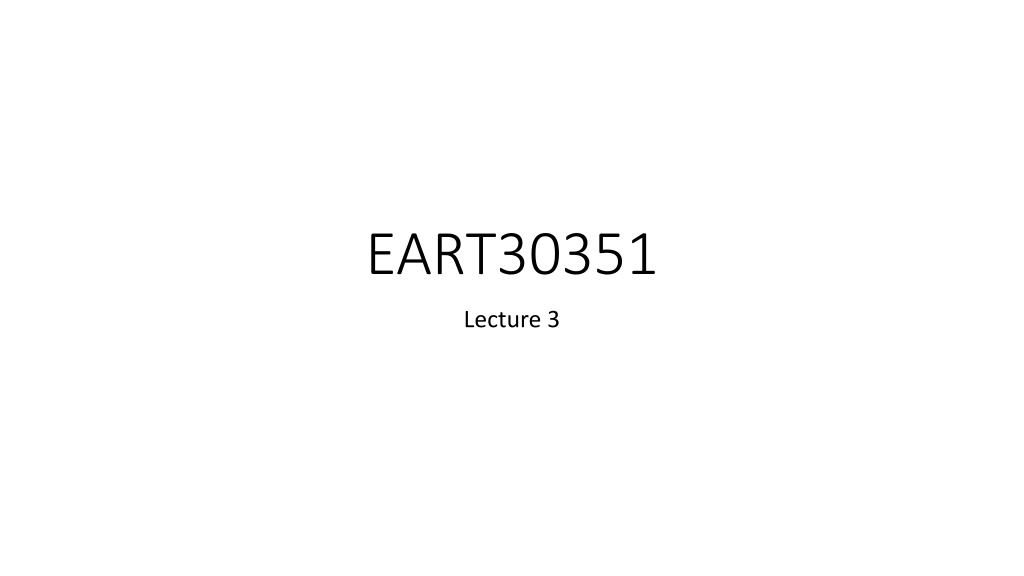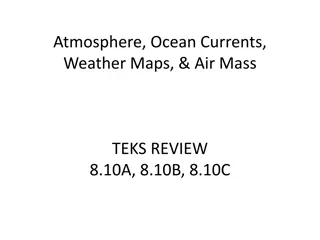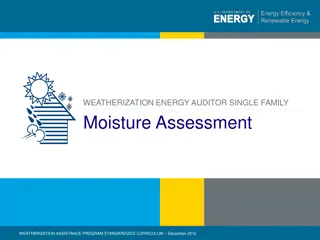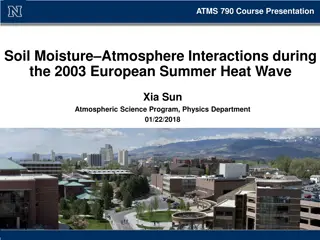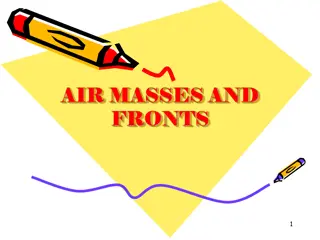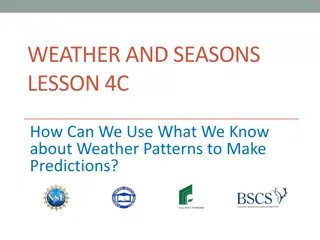Understanding Moisture in the Atmosphere and Its Impact on Weather
Explore the dynamics of moisture in the atmosphere, including concepts like mass mixing ratio, volume mixing ratio, dew point, wet bulb temperature, and saturated vapor pressure. Learn about the Clausius-Clapeyron equation, supercooled water phenomena, and the effects of latent heating on atmospheric thermodynamics. Gain insights into how these factors influence weather patterns and atmospheric behavior.
Download Presentation

Please find below an Image/Link to download the presentation.
The content on the website is provided AS IS for your information and personal use only. It may not be sold, licensed, or shared on other websites without obtaining consent from the author. Download presentation by click this link. If you encounter any issues during the download, it is possible that the publisher has removed the file from their server.
E N D
Presentation Transcript
EART30351 Lecture 3
Moisture in the atmosphere Mass mixing ratio w, gkg-1 Volume mixing ratio x, ppmv w = x where = 18/29 = 0.622 Vapour pressure, mb. e = nwkT (nw= no. water molecules m-3) Dew Point TD, K. Temperature at which a parcel of air cooled at constant pressure reaches saturation. e = es(TD)
Moisture in the atmosphere Mass mixing ratio w, gkg-1 Volume mixing ratio x, ppmv w = x where = 18/29 = 0.622 Vapour pressure, mb. e = nwkT (nw= no. water molecules m-3) Dew Point TD, K. Temperature at which a parcel of air cooled at constant pressure reaches saturation. e = es(TD) Wet bulb temperature, Tw, K. Temperature reached at saturation when water vapour is evaporated into an air parcel, with no extra heat added. Relative humidity, % RH = 100 e/es(T) All these quantities are used in atmospheric physics!
Saturated Vapour pressure, es Vapour pressure in thermo-dynamic equilibrium with the bulk liquid. It is a function only of temperature. For phase change from liquid to vapour, = vas the liquid is so much more condensed. ??=? ? ?? Clausius-Clapeyron Equation: ??? ??= ? Where L is the latent heat for that phase change and the change in specific volume since water vapour behaves like an ideal gas with gas constant r = 8310/18 = 462 J kg-1K-1 ??? ??= ? ?= ? ? ??? ? ?2 So
Solution of Clausius-Clapeyron equation Saturation vapour pressure for water and ice Water vapour latent heat: L = 2.5x106-2.5x103(T T0) J kg-1varies slowly with temperature. So CC equation can be approximately integrated: Saturated vapour pressure, mb 15 Ice Water 10 ? ? 1 ?0 1 ??? ~???0??? ? where T0= 273.15 K More accurate expressions take account of L(T). For ice sublimation, L(273.15 K) = 2.83 J kg-1 5 -40 -30 -20 -10 0 10 Temperature
Supercooled water Water can exist in liquid form in clouds down to -37 C. Liquid drops below 0 C are supercooled: ice particles will grow at the expense of the liquid drops if nucleated. This is the Bergeron-Findeisen mechanism for generating snow and then raindrops. Saturation vapour pressure for water and ice Saturated vapour pressure, mb 10 Ice Water 1 -40 -30 -20 -10 0 10 Temperature
Effect of latent heating Latent heat of evaporation of water (or sublimation of ice) is very large and dominates atmospheric thermodynamics. Ascending air cools more slowly when it saturates, and so remains more buoyant Evaporating precipitation cools the air and causes downdraughts
Effect of latent heating Latent heat of evaporation of water (or sublimation of ice) is very large and dominates atmospheric thermodynamics. Ascending air cools more slowly when it saturates, and so remains more buoyant Evaporating precipitation cools the air and causes downdraughts Change of phase adds or subtracts heat to a parcel of air: dQ = -Ldw where w = mass mixing ratio of vapour Condensation, w < 0 Heat released, Q >0 Thermodynamic equation: dU = cvdT = -Ldw pdV becomes: cpdT = -Ldw + dp
Example: calculation Example: calculation of wet bulb temperature. of wet bulb temperature. Calculation of wet bulb temperature Suppose we start with air at 1000 mb, 20 C with 50% relative humidity. From the graph opposite, es at 20 C is 23.2 mb. Therefore e for the parcel is 11.6 mb (50% of es). Saturation vapour pressure of water 30 As water evaporates, the air cools due to the latent heat of evaporation which is L w J kg-1: Saturation reached at 13.7 C, 15.7 mb when the two lines meet Vapour pressure, mb cp T = -L w = -L x = -L e/p Here w is the mass mixing ratio, x the volume mixing ratio, =18/29 = 0.62, and x=e/p by definition 20 As water evaporates, e increases and T decreases This gives a linear relation between e and T: e = 11.6 0.64(T-20) with e in mb (1 mb = 100 Pa) and T in C Initial e and T 10 The wet bulb temperature is that when the air becomes saturated and can cool no longer. The SVP curve was calculated using the Magnus equation. Initial dew point, TD = 9.3 5 10 15 20 25 Temperature, degC
Saturated adiabatic lapse rate Can calculate a pseudo-adiabatic lapse rate from the thermodynamic equation (see handout), if we assume water droplets have no specific heat capacity. Saturated Adiabatic Lapse Rate, SALR T due to L z DALR = 10 K km-1 Formula is very cumbersome so to solve it we use graphical methods: the tephigram T
